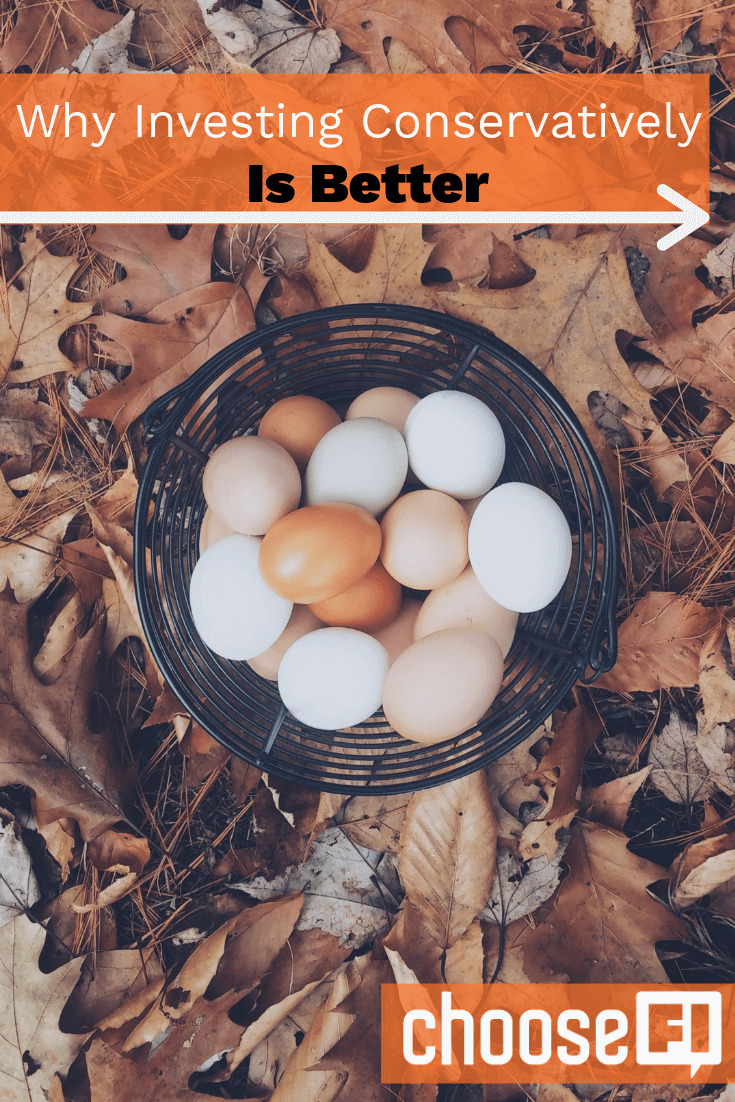When working with clients, I have several ways to determine the correct allocation they should have to stocks and bonds. More often than not, I find that clients are over-allocated to stocks. Therefore, they are taking more risk in their portfolios than needed.
Today, I want to discuss why investing more conservatively is usually better at helping clients meet their financial goals. Having a lower allocation to stocks may seem counterintuitive, but it could help you reach your goals with less risk.
Conservative Allocation: What Does It Mean To Invest Conservatively?
There is no clear-cut definition of what it means to invest conservatively. But, in general, portfolios that are heavy on stocks are considered aggressive. And the more bonds that a portfolio includes, the more conservative it’s considered to be.
Growth Portfolios
There are all types of stock/bond splits that people may choose for their portfolios. But if you have more stocks than bonds, that indicates you are hoping for your portfolio to grow over time.
How aggressive you want to be with your growth portfolio is entirely up to you. If you have a 100% stock/0% bond portfolio, then your portfolio is ultra-aggressive. Even a 90/10 portfolio would be considered an aggressive strategy by most.
From there, people can choose all kinds of splits depending on their risk appetite. Some people feel comfortable with an 80/20 split, while others may feel better with a 70/30 split.
But until you reach a 50/50 split, your portfolio would still be in the “growth” category.
Preservation Portfolios
Once you have more bonds in your portfolio than stocks, you’ve moved into the “wealth preservation” zone.
Conservative investors win in the long term. As people get closer to retirement, some shift into wealth preservation mode by choosing an asset allocation that’s nearly 100% bonds. Many target retirements funds will steadily increase the percentage of bonds in your portfolio as you approach your retirement date.
Retiring early presents a different set of problems, however. If you’re planning to live off your investments for 30 years or more, you may not be able to afford to have an ultra-conservative portfolio in retirement.
But whether you plan to retire early or not, I maintain that your portfolio should include at least some bonds.
And, yes, I know that many people would disagree with that perspective. Let’s discuss why so many people are against a conservative investing strategy.
Related: Asset Allocation When You Plan to Retire Early
Conservative Allocation: Why Investing Conservatively Often Gets A Bad Rap
If you Google “Should I invest in bonds?”, you’ll have no trouble finding article after article chiding you for even thinking about including bonds in your investment portfolio.
“Experts” will point to the statistics that show that stocks outperform bonds over time. They’ll use all kinds of charts and statistics to prove that investing in anything besides equities is a waste. Market volatility is what they ignore.
Let me be clear–these people have good intentions. And they’re not necessarily using bad data either. If you could really put your money in a stock-heavy portfolio and not think about those funds again until you retire, you’d probably end up in great shape.
And yes, you’d probably make a little more money over time with a 90/10 stock/bond split vs. an 80/20 or 70/30.
But what statistics can’t show is the emotional turmoil that comes with riding out the ups and downs of aggressive investing choices.
You could be tempted to hold money back during the downturns instead of contributing money on a consistent, monthly basis.
Conservative Allocation: The Psychological Advantage Of Conservative Investing
I believe limiting your risk allows you to keep more of what you earn rather than giving a large portion of it back during the next downturn. High quality index and mutal funds are your best bet.
With that in mind, lower stock allocations through rebalancing may limit the upside. However, it also limits the downside and can increase the final portfolio value after a full stock market cycle.
For argument’s sake, please endure my simplified math of investment returns. I have used a 12% rate of return for stocks and zero for bonds. I chose these numbers due to the “Rule of 72”, which tells you how long it will take (approximately) for your money to double.
Scenario One
- If you invested $10,000 with an original allocation of 60% stocks and 40% bonds, after a 100% increase in stocks over six years, your account would likely have $15,840 in it.
- If stocks then decline by 35%, you will end up with $11,700. A rather high risk investment.
Scenario Two
- Alternatively, suppose you maintain your 60% allocation to stocks by rebalancing the portfolio at the end of the year that your allocation rises above 65% stocks. In that case, you will have a total account value of $15,300.
- If stocks now decline by 35%, your 60% allocation will limit portfolio losses to 21%, and you’ll end up with a portfolio value of $12,100
By using a properly allocated and rebalanced portfolio, you will have less of a wild ride up. But you’ll also save yourself the terror of the roller coaster ride down.
Related: How To Prepare For Drawdown During Early Retirement
Keeping Emotions In Check
With the above examples, would you have stuck it out during the downturn?
In reading the first example, I’m sure you would have stuck to your guns. However, after reading the second example, maybe you’re not so sure.
I think that educated investors know that their stocks are not going to go to zero.
Therefore, during a downturn, they’re not thinking about losing all of their money forever. Instead, the doubts of “they’re not losing as much as me” or “maybe I was taking too much risk” creep in and they change their allocation at or near the bottom.
It’s the comparison game that comes in to bite us!
It’s essential to manage your emotions as an investor. I think the easiest way to do so is to dial back your risk when times are good. This helps limit your risk during those downturns.
Sure, the loss of upside will be painful. But let me be clear, the pain in the downturns is exponentially worse!
How Much Risk To Take
When determining a client’s rate of success, we are rarely aiming for an infinite amount of money.
Instead, we are trying to get clients through their lives with enough money to meet their spending needs and still leave some assets to their heirs. Our goal is a number greater than zero.
Some clients have an inheritance goal–say $1,000,000 per child. This is still much easier to target than “as much money as possible.”
Many robo-advisors offer goal-setting features as well. Betterment’s “Investment Goals,” for instance, are well-known for being incredibly well-thought-out and helpful. And Wealthfront’s “Path” financial planning software has some tremendous goal-setting features as well.
Why is setting goals is so important? Once you have an actual number to reach for, you can determine the minimum rate of return to reach this figure reliably. Then, any deviation from this rate of return can be defined as “risk.”
Staying On Track
To reach our goal, we want to stay as close to on track as possible. Usually, investors don’t view above-average returns as risk. Therefore, when stock markets are trending upwards, investors tend to increase their stock allocation to grab the higher returns. This increases the percentage of stocks in their investing portfolios in two ways.
- First, they are either selling other assets and moving them to stocks, or they are simply adding more money to the stock portion of their portfolios.
- Second, the overall value of the stocks is increasing, which in and of itself would increase the percentage of stocks in their portfolio. This often makes investors over-allocated to stocks in the latter part of a bull market.
When the downturn comes, those investors will likely experience outsized losses in their portfolios, especially compared to their original expectations.
For example, if you started out investing 60% in stocks and the market increases by 100%, you will now have a 75% stock allocation if you did not rebalance.
The normal portfolio decline in a bear market is 21% for a 60% stock investor. However, since the stock allocation is now at 75%, this investor has an increased decline of 26%.
The takeaway here is to determine the required rate of return to meet your goals. It’s easy to find historical rates of return for stocks and bonds. So, with the target rate of return, it should be pretty easy math to come to portfolio allocation.
Conservative Allocation: Finding The Right Balance
The key to investing is to find the right balance.
You want your assets allocated in investments aggressive enough to provide the return you’ll need to reach FI by your target date. But at the same time, you want them to be conservative enough that you won’t be afraid to pour money in even during bear markets.
When we run simulations for clients, one of the items we check is the impact of the allocation against the chances of success, with success defined as how likely they are to reach their goals. By reducing the client’s stock allocation, they are usually surprised that their rate of success increases.
The reason is twofold. First, by limiting risk, you keep more of what you earn. Second, you are also more likely to stick to your investment strategy. A conservative investment portfolio is not only comfortable for those who have a low risk tolerance, but works in your favor by keeping the lion’s share of your returns.
Our planning model can quantify the effect of keeping more of what you earn. Unfortunately, it can’t quantify the likelihood that a client’s investment strategy will change during the downturn. Therefore, the increase in the chance of success is probably even greater than shown in our simulations!
Rebalancing Your Asset Allocation Over Time
The best way to systematically reduce risk is by rebalancing when your allocation gets out of whack. You can replenish your stock allocation as markets are falling and stocks get cheaper. This works during downturns as well.
Once again, this takes emotions out of the picture. It allows you to maintain the target allocation and make purchases while others are running from stocks.
Academic literature says that rebalancing hinders accumulation of wealth, since letting your stock allocation continue to rise will statistically increase future returns. However, if your ultimate goal is to reach the end of your life with enough money to meet your spending needs and leave money to heirs, you don’t need to target infinity. You just need a number greater than $0.
Limiting your risk while eliminating the chance to reach infinity, will allow you to sleep better at night. It may even reduce the risk of a heart attack when you open those brokerage statements in the future!
If you use a wealth management office, tell your advisor that you’d like to discuss your options for periodically rebalancing your portfolio. And if you use a robo-advisor like Betterment or Wealthfront, most can automatically rebalance your portfolio to keep it in line with your risk profile.
Related Articles
- Your End Of The Year Investing Checklist
- M1 Finance Review–Completely Free Automated Investing
- Where Should You Invest? How To Determine Your Asset Allocation




